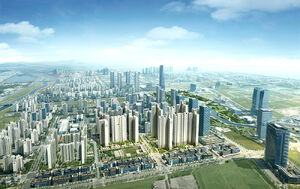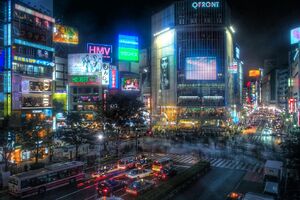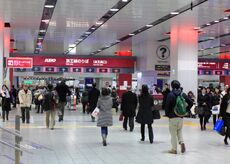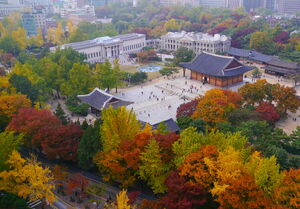| Celestial City | |
| City | |
| Clockwise from top: Guardian Park, Mirai Maglev Terminal, Financial District, and the Imperial Parliamentary Complex. | |
| Country | Imperial Union of Gaia |
| Province | Central Province* |
| District | Imperial Capital Region |
| Government | |
| - Governor-Viceroy | Mina de Gaia |
| - Mayor | George Wong |
| Events | |
| - Formation | |
| Population | |
| - City | 3,887,006 |
| - Metro | 6,500,000 (Estimate) |
| - Rank | 1st, Gaia |
| Demonym | Celestial |
| geoTLD | .cc.gaia |
| *Celestial City is located within Central Province, but is not considered part of it. | |
Celestial City is the capital of the Imperial Union of Gaia. The city is the largest city in the country and is home to the Gaian government and the Imperial Family. The city was built during the Expansion Era, after the passing of the National Capital Act. As part of the Act, the city is exclusively under the jurisdiction of the Imperial Government and is not part of any province. It also became one of the world's largest construction projects and the world's largest planned city as a result. Celestial City has approximately 3 million inhabitants, making it one of the most populous cities in the country.
Celestial City is home to the Imperial Parliament as well as many branches of the Imperial government. The Imperial Parliamentary Complex houses both houses of the Imperial Parliament, the Senate and the Imperial Assembly. The city also hosts foreign embassies and the headquarters of numerous corporations, and organizations. The government district is situated on the southern end of the city, on reclaimed land from Celestial Bay. Guardian Park is the central boulevard and park space that runs through the center of the government district. Bylaws restricting tall buildings are in effect for the government district and its surrounding areas. The Imperial Parliamentary Complex sits at the northern end of Guardian Park, where a canal separates the government district from the rest of the city. At the southern end of Guardian Park, facing Celestial Bay, is the residence of the Imperial Family.
Aside from being a major center of government, Celestial City is home to various corporations and is known for its great shopping atmosphere. One of the country's largest shopping centres is situated in the city. Mirai Mall, which bares the name of the country's leading software and electronics manufacturer, has thousands of shops many of which sell electronics. The mall is also a major transit hub for the city as it intersects many rapid transit lines, and rail lines. The mall also serves as a dividing point between the densely built up downtown area and the rest of the city.
History
The city was built during the Expansion Era as part of the National Capital Act, which mandated the construction of a new capital for the country. After the signing of the Sora Agreement, the new government was tasked with finding a suitable site for the country's new capital. After months of surveying the regions east of Sora, the Gaian Colonial Authority submitted a list of suitable sites for the new capital to the Emperor and his government. The site on the northwestern shores of Aounabara Bay was eventually chosen. The name "Celestial City" was eventually chosen for the name of the new capital, after long meetings between various government officials and the Emperor.
On March 16th, 3022, the city was officially founded and construction began shortly afterwards. Groundwork for the construction of the city began with the clearing of approximately 25km² of land adjacent to Aounabara Bay. By mid-November the highway linking Celestial City and Sora was complete.

Celestial City in 3030
The government appointed David Powell, a renowned architect and civil engineer who helped design many of Sora's key buildings, as chief city planner for Celestial City. He devised an ambitious plan which would result in the city becoming one of the world's largest planned cities. The plan called for the establishment of a grid-like city blocks with wide avenues and boulevards separating each city block, and grand monuments and plazas along the main boulevard, which began at the proposed site of the Imperial Parliamentary Complex. By 3024, the Imperial Parliamentary Complex was complete and the city's grid-like city blocks were established. The area southwest of the original Imperial Parliamentary Complex would be later reclaimed from Aounabara Bay, for the construction of the Government Ward. By 3030, the "core areas" of the city are completed and the seat of government officially moved from Sora to Celestial City.
Expansion
By the 3050's the city had grown to nearly double its previous size, with the population steady rising as the city and national government expanded services and approved of new infrastructure projects. By early 3060, the superhighways N-1 and N-2 reach Celestial City, and greatly increase the city's economic prospects.
Geography
Celestial City is situated in the central part of Gaia, on the northwestern end of Aounabara Bay. The city is situated in the Imperial Capital Region, to the north of Aounabara Prefecture. The city and the capital region are subdivided into numerous wards.
Cityscape

Hokari District
The architecture in Celestial City is largely influenced by the architects and city planners of the New Era and by the Imperial Family. As a planned city, all new buildings within the city boundaries must be approved by a committee of city planners and the Governor-Viceroy. Various city bylaws prevent buildings from reaching certain heights in certain areas within the city. As a result, many of the country's tallest buildings are located in other cities. The tallest structures within Celestial City are mostly located within the city's Financial District and the encompassing Midoru Ward. Buildings located near the Government Ward of the city are under the greatest scrutiny.
Much of the cityscape today is the result of the mass urban renewal projects of the New Era, which saw the city evolve into the beautiful sprawling metropolis of today. From the construction of wide boulevards to the creation of many city parks, numerous city beautification programs throughout the history of the city have contributed to the city's beauty.
Climate
The climate in Celestial City is fairly mild and predictable. Summers are generally warm, while winters are generally cold and snowy. The city receives a fair amount of precipitation during spring, autumn and winter months.
Government
Under the National Capital Act, Celestial City receives special oversight from the national government. It is the only city in the entire country governed by a Governor-Viceroy, who is appointed by the Empress. The Governor-Viceroy is not involved directly in the administrative affairs of the city, but is responsible for approving bylaws and projects within the city boundaries. The administrative head of the city is the mayor. Mayors are elected by the residents of the city, and are responsible for the daily operations of the city.
City Hall
The city is divided up into 15 wards, all of which are roughly the same size. The residents of the city are able to elect two city councillors from their home ward. This means the Celestial City municipal government is comprised of 30 city councillors, which includes the mayor. The municipal government has various departments created for the daily operations of the city. They include the Department of Public Works, and the Department of Utilities. The Celestial City Hall serves as the headquarters for the governments of Celestial City and the Imperial Capital Region.
A majority of government offices, excluding municipal government offices, are located in the city's Government Ward, which lies south of the Grand Canal. The ward is home to a significant number of offices belonging to the Gaian government, and all of the foreign embassies located in Gaia. The ward is also home to the Imperial Parliamentary Complex, which is home to both houses of the Imperial Parliament.
| Northern Region | ||
|---|---|---|
| ||
| Western Region | Central Region | Eastern Region |
|
|
|
| Southern Region | ||
|
Economy
A significant percentage of Celestial City's inhabitants are employed by the Gaian government and corporations headquartered in the city. Residents of Celestial City enjoy one of the highest standards of living in the country and the lowest unemployment rates. The city is also an important business and financial hub, generating a fairly percentage of the country's GDP compared to other cities. Economic development remains steady in the Celestial City and the Imperial Capital Region, as the city continues to be a desirable place for businesses and investment.
Many major Gaian corporations are headquartered in the city, including the tech giants, Mirai Corporation and Ishimiya Technologies. Other notable companies with their headquarters in Celestial City, include the state-owned insurance company GaiaCare, and the state-owned Saito Development Corporation. Entities such as the Celestial Stock Exchange and the Bank of Gaia have their headquarters located in the city's financial district.
The city also benefits economically, from its diverse retail landscape. Some of the country's largest shopping centres are located within the Imperial Capital Region. Located on the shoreline of Aounabara Bay is Ohyo Outdoor Market, one of the regions largest markets, which offers a variety of retail products, produce, and seafood. The Hokari District features some of the city's trendiest shopping and entertainment venues. Venues such as the upscale Mirai Mall are located within the area.
Tourism is a large contributor to the city's economy. Approximately 70% of tourists who enter the country, visit the city. Entertainment districts within the city, such as Hokari District, attract a large portion of tourists. The city is currently the focus of the country's latest tourism promotion campaign, "Go Gaia".
Transportation
Celestial City, being located in a very central part of the country, is a major hub for transportation. The city features one of the world's most advanced transportation systems, which is under constant expansion. Much of the country's maglev network intersects in Celestial City, at the Mirai Maglev Terminal. For citywide travel, the municipal government operates an extensive network of subways and bus routes.

Chuoko Station
The Celestial City Metro is the city's comprehensive subway system that connects each of the city's wards and the outlying areas of the Imperial Capital Region. With well over a million passengers a day, the city has one of the busiest subway systems in the world. For safety, all subway stations in the network are outfitted with screen doors to prevent access to the subway tracks.
Maiagaru International Airport, located in the northwestern fringes of the Imperial Capital Region, is a major port of entry into Gaia and serves as a major hub for a number of Gaian aerospace corporations, such as Sora Airways, TransGaia, and Gaia Airlines.
Education
Celestial City has one of the best education systems in the country. All schools in the city, excluding post-secondary schools, are operated by the municipal government of Celestial City, through the Celestial City Board of Education.
Celestial City hosts a large number of post-secondary institutions, many of which are located in the city's suburbs. Notable schools include Celestial University, Choetsu Institute of Technology, and Fujou International Academy.
Culture

The National Museum of Gaian History
As the capital of Gaia, Celestial City hosts some of the country's largest and most important cultural institutions. Cultural institutions located within Celestial City include the Gaian Museum of Technology and Innovation, the National Arts and Culture Institution and the National Museum of Gaian History. The National Museum of Gaian History, which shares a 40 acre piece of land adjacent to the Government Ward with the National Archives of Gaia, is by far the largest cultural institution in Gaia.
The city also hosts numerous festivals and cultural events throughout the year. Major festivities include the Night of the Stars Festival, Gaia Day celebrations and the Winter Solstice Festival. During the summer months the city is host to the Celestial City International Fireworks Festival, which lights up the city skies from Aounabara Bay.
Sister cities
In 3537, Celestial City became the first city in the country to enter international sister cities arrangements.
 Auronopolis, Hellenian Empire (3537)
Auronopolis, Hellenian Empire (3537)









